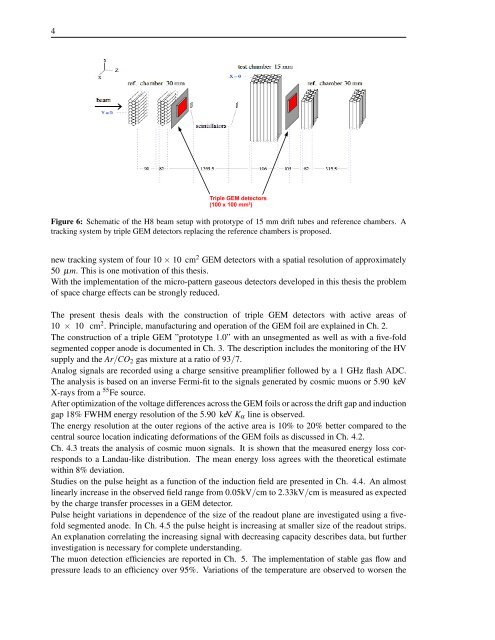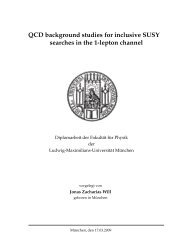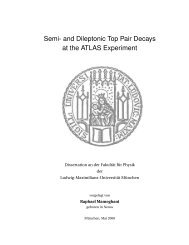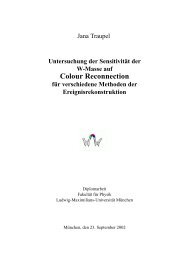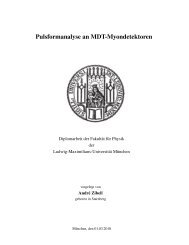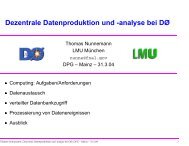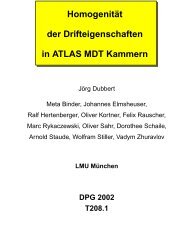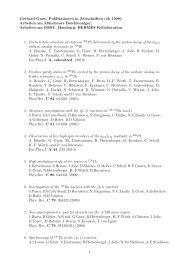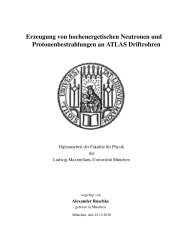development of micro-pattern gaseous detectors – gem - LMU
development of micro-pattern gaseous detectors – gem - LMU
development of micro-pattern gaseous detectors – gem - LMU
Create successful ePaper yourself
Turn your PDF publications into a flip-book with our unique Google optimized e-Paper software.
4<br />
Triple GEM <strong>detectors</strong><br />
(100 x 100 mm²)<br />
Figure 6: Schematic <strong>of</strong> the H8 beam setup with prototype <strong>of</strong> 15 mm drift tubes and reference chambers. A<br />
tracking system by triple GEM <strong>detectors</strong> replacing the reference chambers is proposed.<br />
new tracking system <strong>of</strong> four 10 × 10 cm 2 GEM <strong>detectors</strong> with a spatial resolution <strong>of</strong> approximately<br />
50 µm. This is one motivation <strong>of</strong> this thesis.<br />
With the implementation <strong>of</strong> the <strong>micro</strong>-<strong>pattern</strong> <strong>gaseous</strong> <strong>detectors</strong> developed in this thesis the problem<br />
<strong>of</strong> space charge effects can be strongly reduced.<br />
The present thesis deals with the construction <strong>of</strong> triple GEM <strong>detectors</strong> with active areas <strong>of</strong><br />
10 × 10 cm 2 . Principle, manufacturing and operation <strong>of</strong> the GEM foil are explained in Ch. 2.<br />
The construction <strong>of</strong> a triple GEM ”prototype 1.0” with an unsegmented as well as with a five-fold<br />
segmented copper anode is documented in Ch. 3. The description includes the monitoring <strong>of</strong> the HV<br />
supply and the Ar/CO2 gas mixture at a ratio <strong>of</strong> 93/7.<br />
Analog signals are recorded using a charge sensitive preamplifier followed by a 1 GHz flash ADC.<br />
The analysis is based on an inverse Fermi-fit to the signals generated by cosmic muons or 5.90 keV<br />
X-rays from a 55 Fe source.<br />
After optimization <strong>of</strong> the voltage differences across the GEM foils or across the drift gap and induction<br />
gap 18% FWHM energy resolution <strong>of</strong> the 5.90 keV Kα line is observed.<br />
The energy resolution at the outer regions <strong>of</strong> the active area is 10% to 20% better compared to the<br />
central source location indicating deformations <strong>of</strong> the GEM foils as discussed in Ch. 4.2.<br />
Ch. 4.3 treats the analysis <strong>of</strong> cosmic muon signals. It is shown that the measured energy loss corresponds<br />
to a Landau-like distribution. The mean energy loss agrees with the theoretical estimate<br />
within 8% deviation.<br />
Studies on the pulse height as a function <strong>of</strong> the induction field are presented in Ch. 4.4. An almost<br />
linearly increase in the observed field range from 0.05kV/cm to 2.33kV/cm is measured as expected<br />
by the charge transfer processes in a GEM detector.<br />
Pulse height variations in dependence <strong>of</strong> the size <strong>of</strong> the readout plane are investigated using a fivefold<br />
segmented anode. In Ch. 4.5 the pulse height is increasing at smaller size <strong>of</strong> the readout strips.<br />
An explanation correlating the increasing signal with decreasing capacity describes data, but further<br />
investigation is necessary for complete understanding.<br />
The muon detection efficiencies are reported in Ch. 5. The implementation <strong>of</strong> stable gas flow and<br />
pressure leads to an efficiency over 95%. Variations <strong>of</strong> the temperature are observed to worsen the


